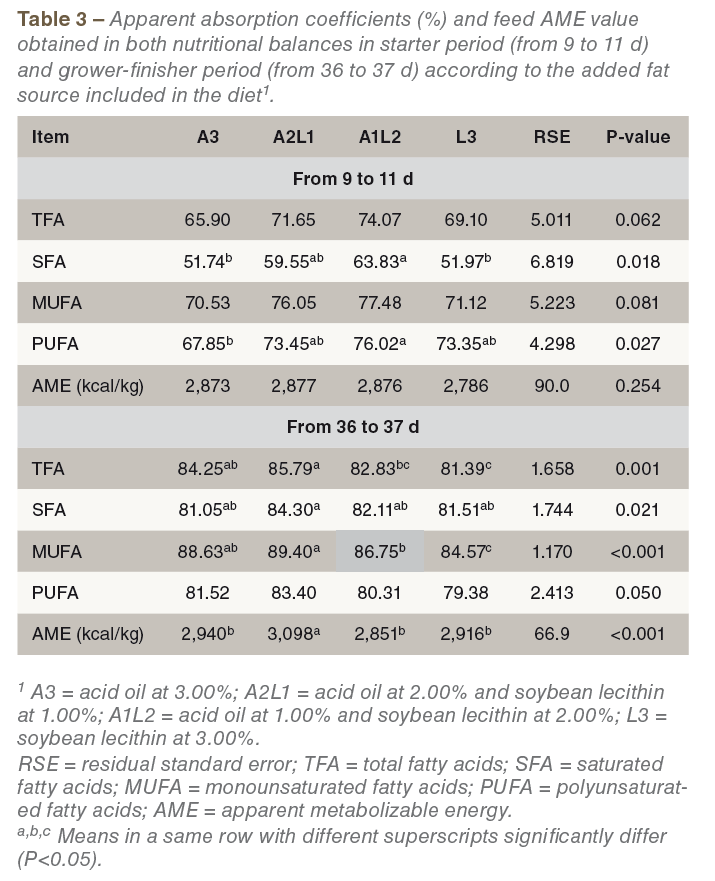
Lecithin and acid oil, as co-products from vegetable oil refining process, are economic alternatives to conventional fat sources and may represent an efficient energy source for broiler nutrition. Lecithin is a lipid mixture mostly composed by phospholipids that presents emulsifying properties, and on the other hand, acid oil contains free fatty acids as main components.
The aim of this experiment was to study the effect of a combination of vegetable acid oil with crude soybean lecithin on performance parameters, as well as energy and fatty acid utilization. A total of 96 Ross 308 newly hatched female broiler chickens were randomly distributed in 24 metabolic cages and assigned to four experimental treatments (6 replicates/treatment).
A basal diet was supplemented with 3% of acid oil (A3); 2% of acid oil and 1% of lecithin (A2L1); 1% of acid oil and 2% of lecithin (A1L2); and 3% of lecithin (L3). Titanium dioxide (TiO2) was added as indigestible marker at 0.5% and two nutritional balances were performed between 9-11 d (starter period) and 36-37 d (growing-finishing period) of age. No differences were seen in performance between either acid oil or lecithin diets. In the starter period, broilers fed 2% of lecithin in contrast to 3% of acid oil demonstrated higher utilization (P<0.05) of saturated fatty acids (SFA; A1L2: 63.83 and A3: 51.74%) and polyunsaturated fatty acids (PUFA; A1L2:76.02 and A3:67.85%).
However, no differences were observed between treatments in total fatty acids (TFA) and monounsaturated fatty acids (MUFA) utilizations, and feed AME value. In growing-finishing period, the best results were shown in broiler chickens fed A2L1, that present the highest feed AME (P<0.01), and a higher digestibility of SFA compared to animals fed A3, and a higher digestibility of TFA and MUFA compared to animals fed L3. Based on the results from this study, the best strategy to include both energy sources in broiler feeding is its inclusion in starter period in a blend of 2% of lecithin and 1% of acid oil, whereas in grower finisher period, combine both fat sources with a 2% of acid oil and 1% of lecithin.
Introduction
Production costs in poultry industry are mainly due to feed, resulting in more than the 60% of companies total input. In addition, worldwide animal production increasing in the last years, caused mainly by the growing global population, put in risk the availability and the supply of traditional ingredients included in broiler feeding. Added fat inclusion in broiler feeding is an essential activity for meeting the high energetic requirements of broiler chickens and furthermore, presents other positive features (essential fatty acids and vitamins supply, palatability enhancers, among others).
Exist an increasing interest in alternative energy sources that enables a reduction in production costs and at the same time maintain the production efficiency and quality. Based on this, co-products and by- products derived from vegetable oil refining process, such as acid oil and lecithin, represent an interesting option. Acid oils are characterized by a higher proportion of free fatty acids (FFA) and lower proportion of triglycerides (TAG) with a similar fatty acid (FA) profile compared to the native oil. However, some authors have reported that its high level in FFA concentration causes a reduction in energy utilization. On the other hand, soybean lecithins are a lipid mixture obtained from oil degumming process and are mainly characterized by be composed with a high content in phospholipids and, in a minor proportion, by crude soybean oil. Due to its chemical composition, lecithins represents a good source of energy, linolenic acid, vitamin E and choline, and in addition, presents emulsifying properties.
The aim of this experiment was to evaluate different grades of combinations of both alternative energy sources in broiler feeding and their influence on performance parameters, feed apparent metabolizable energy (AME) value and FA digestibility.
Materials and methods
Animals and facilities
The experimental procedure was approved by the Animal Ethics Committee of the Universitat Autònoma de Barcelona (CEEAH) and were in accordance with the European Union Directive for the care and use of animals in research (European Parliament, 2010).
The experiment was performed at Servei de Granges i Camps Experimentals (UAB, Bellaterra, Barcelona, Spain). A total of 96 Ross 308 newly hatched female broiler chickens were obtained from a commercial hatchery, weighed, wind-tagged, randomly distributed and housed in cages with a grid floor and a tray for excreta collection and allotted to 4 experimental treatments. Each experimental treatment was replicated 6 times with 4 chicks per cage. Broiler chickens were allowed to consume both feed and water ad libitum in an environmentally controlled room and the temperature program used was consistent with the specifications in the Ross 308 lineage management handbook (2014).
Experimental design and feed
A 38 d growing period was conducted and divided in two phases: starter period (0-21 d) and grower- finisher period (21-38 d). All diets were formulated to meet or exceed the nutrient requirements for broilers.
 Broiler chickens received a starter and a grower-finisher feeds, both in mash form and based in wheat and soybean meal. For both periods the basal diet was supplemented with a 3.00% of supplemented fat: acid oil (9429 kcal/kg gross energy; 51.2% in FFA) or lecithin (8105 kcal/kg gross energy; 4.2% in FFA) in a different combination (Table 1). The fatty acid profile of starter and grower-finisher experimental diets are shown in Table 1. In addition, TiO2 (titanium dioxide) was included at 0.50% in diet as inert marker to calculate the FA digestibility and the AME value of the feed.
Broiler chickens received a starter and a grower-finisher feeds, both in mash form and based in wheat and soybean meal. For both periods the basal diet was supplemented with a 3.00% of supplemented fat: acid oil (9429 kcal/kg gross energy; 51.2% in FFA) or lecithin (8105 kcal/kg gross energy; 4.2% in FFA) in a different combination (Table 1). The fatty acid profile of starter and grower-finisher experimental diets are shown in Table 1. In addition, TiO2 (titanium dioxide) was included at 0.50% in diet as inert marker to calculate the FA digestibility and the AME value of the feed.
Controls, sampling and laboratory analyses
Broiler body weight (BW) and feed intake were recorded on cage at the day of hatch, d 21 and d 38 post-hatch. The data were used to calculate BW, average daily gain (ADG), average daily feed intake (ADFI) and feed conversion ratio (FCR). Mortality was recorded daily to adjust ADFI and ADG.
Two nutritional balances were performed between d 9-11 (starter period) and d 36-37 (grower- finisher period) and homogeneous samples of excreta were collected. During the collection, contaminations of feed, scales and feathers were removed from the excreta. Excreta samples were freeze-dried, grinded, homogenized and kept at 5ºC for further analysis. In addition, experimental feed samples were taken at the beginning and end of each part of the experimental periods for analysis.
Feed dry matter, crude protein, ether extract, ash and crude fiber of feed were analyzed by the methods described by AOAC (2005). Gross energy from feed and excreta was determined by adiabatic bomb calorimeter, and FA profile was determined following the method described by Sukhija and Palmquist (1988) adding nonadecanoic acid (C19:0, Sigma–Aldrich Chemical Co.; St. Louis, MO) as an internal standard.
Digestibility calculations and statistical analysis
Titanium dioxide concentration was determined in feed and excreta using the method described by Short et al., (1996), and the apparent digestibility of FA (%) was calculated using the following equation:
Apparent digestibility of FA=1-{(TiO2/FA)D/(TiO2/FA)E}.
Where (TiO2/FA)D is the concentration of the inert marker in the diet and (TiO2/FA)E is the concentration of the inert marker in the excreta. Apparent metabolizable energy (AME) was calculated by the following equation: AME (kcal/kg) = Apparent digestibility of GE (%) * GE of the diet.
Cage means were used as experimental units in performance parameters and nutritional digestibility coefficients. Results were analyzed by one-way ANOVA using R Statistics (version 3.3.1), and Tukey’s multiple range test was used to determine whether means were significantly different (P<0.05).
Results and discussion
Performance results
The effect of different added fat sources used in the experimental diets on broiler performance parameters figure below in Table 2.
The experimental procedure was developed with normality, as the performance results show. No differences were observed in performance results for any parameter depending on their added fat source in any phase of the study (P>0.05).
Many authors have discussed the role that can play by-products and co-products as alternative fat sources (in this case, derived from oil refining process) in broiler production due to their economic benefit. Huang. et al., (2007) replaced one of the most included fat sources in broiler feed, soybean oil, by soybean lecithin to study his influence on grow performance and observed that their combination in a proportion of soy-oil/soy-lecithin of 75/25 and 50/50 improved global FCR. On the other hand, Pekel et al., (2013) observed that the replacement of soybean oil by acid oil did not modify any performance parameter in a broiler trial. In addition, Peña, J.E.M et al., (2014) and Borsatti, L. et al., (2017) reported in their studies that these energy sources may be included in broiler feeding without compromising the productive efficiency.
Nutrient digestibility balance and feed AME value
The effect of the inclusion of acid oil and soybean lecithin in fatty acids digestibility and feed AME values on both nutrient digestibility balances figure in Table 3. Results from starter period digestibility balance (excreta collected between day 9-11) showed statistical differences (P<0.05) in saturated fatty acids (SFA) and polyunsaturated fatty acids (PUFA), proven that animals fed A1L2 digested better that fatty acids than animals fed A3. In addition, a tendency (P<0.10) showed the same for total fatty acids (TFA) and monounsaturated fatty acids (MUFA). However, this statistical difference was not observed for feed AME value. In the case of the results from grower-finisher digestibility balance (excreta collected between day 36-37), statistical differences (P<0.05) were observed for all parameters except for PUFA (P=0.05). Animals fed A2L1 showed the highest feed AME value and better utilizations in TFA and MUFA regarding to animals fed L3 and higher digestibility of SFA compared to animals fed A3. Furthermore, the mixture treatment A2L1 obtained, numerically, the highest values for all parameters.
As many authors have reported, it is possible to observe marked differences between the apparent digestibility coefficients of FA in young broilers (starter period) in relation to adult broilers (grower- finisher-period). In addition, in the starter period, it is possible to observe higher utilizations for unsaturated fatty acids (UFA) than SFA. It has been extensively documented that young birds have a limited capacity of fat digestion and absorption, and due to this, a lower energy utilization, especially marked for long chain SFA. This situation is caused due to many reasons, but in particular to a limited bile secretion in young chicks and the difficulty to emulsify and digest long chain FA and SFA due to their physicochemical properties.
Acid oil and soybean lecithin present a different chemical composition, as it figures in Table 1, showing that diets containing acid oil are more (mono)unsaturated and presenting higher amounts of FFA, while diets containing soybean lecithin contains higher quantities of SFA and PUFAs and much less FFA. Furthermore, acid oil presents an average higher heat combustion than soybean lecithin. Treatments resultant from mixing both fat sources, A1L2 and A2L1, obtained, numerically, the highest utilizations for FA in starter period and grower-finisher period, respectively. On the other hand, due to its FFA high concentration, animals fed A3 obtained, numerically, lower absorptions in starter digestibility balance. Many authors have reported that blending different fat sources with variated physicochemical properties may enhance FA absorption by an interaction. We have theorized that is manly caused by the combination of high amounts of FFA with emulsifying phospholipids from the lecithin.
Conclusions
Based on the results from this study, we concluded that the best strategy to include acid oil and soybean lecithin as energy sources in broiler feeding is its inclusion in starter period in a blend of 2% of lecithin and 1% of acid oil, whereas in grower finisher period, combine both fat sources with a 2% of acid oil and 1% of lecithin.
References are available on request
From the Proceedings of the 2018 6th Mediterranean Poultry Summit



















